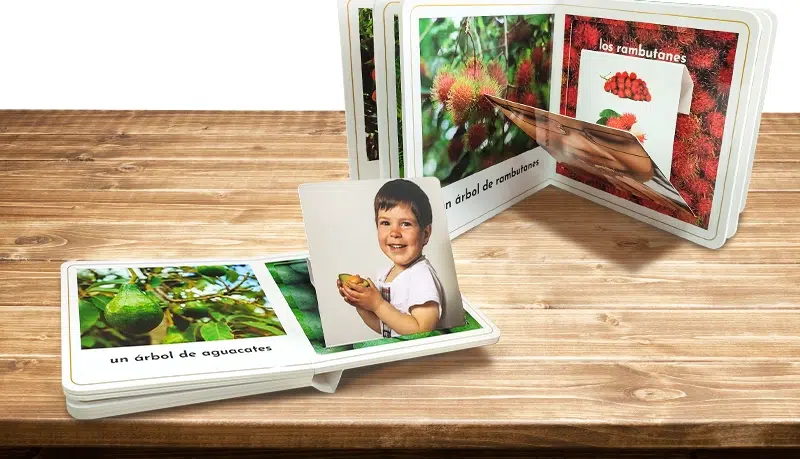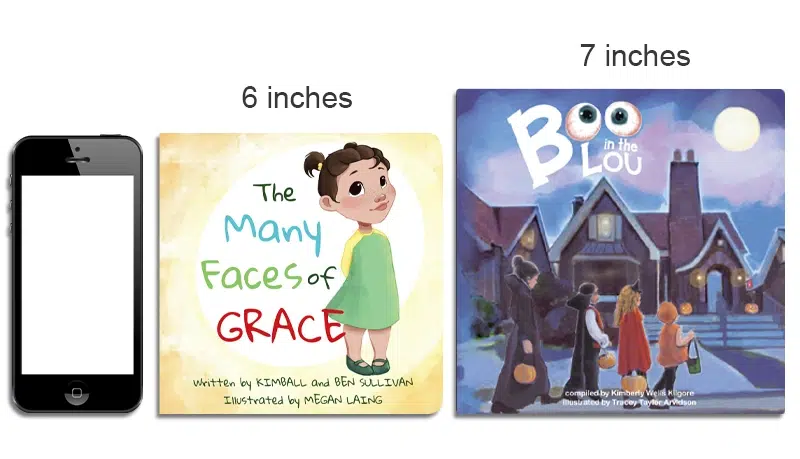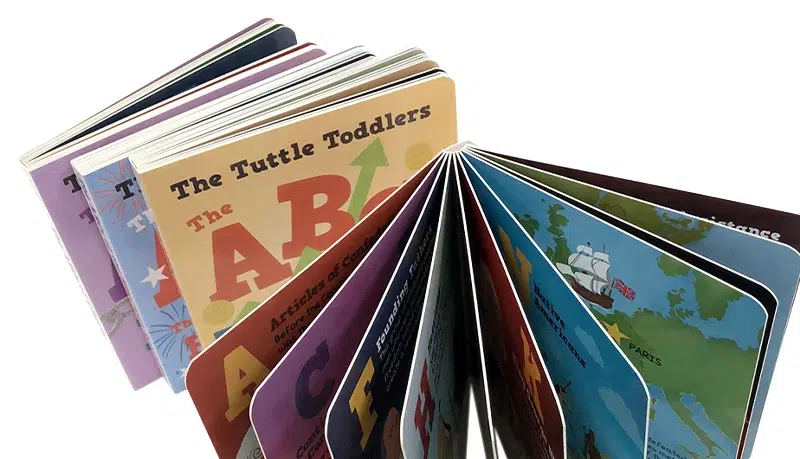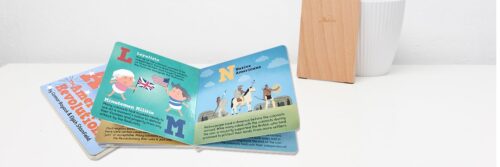The children's board book market grows year-on-year. While it offers great opportunities, it's increasingly competitive. Making your board book interactive can give you the edge with added value at little extra cost.

Welcome to this post on the why and how of designing interactive children’s board books. In the next few minutes, we will explore the advantages of this increasingly popular niche and the essentials of the process of creating engaging and educational board books for young children. Whether you are a passionate children’s book writer, an independent book designer, or a publishing house editor considering a new line, interactive board books can be a valuable tool for enhancing children’s reading experience, tapping into the burgeoning market, and making a healthy profit.
Why choose interactive board books?
Interactive children’s board books offer a unique reading experience that goes beyond traditional storytelling. These books engage children through various interactive elements such as pop-ups, touch and feel textures, flaps, pull downs, and more. They provide a hands-on approach to reading that captivates young minds and encourages their active participation.
Here are some reasons interactive board books are a popular choice for children:
1. Engaging and entertaining
Interactive board books feel more like a game than a book, making them highly engaging for children. The interactive nature of these books keeps children entertained and helps with fostering a love for reading from an early age. They’re especially useful for children who are reluctant to read or engage in conversation as the activity aspect of the book acts as a bridge across the potential barriers, encouraging them to develop literacy skills without them even knowing that they’re doing it.
2. Cognitive and fine motor skill development
Interactive board books stimulate children’s cognitive and fine motor skills. Through various interactive elements, children develop their comprehension, problem-solving, and decision-making abilities. They also improve their hand-eye coordination and dexterity while exploring the distinct features of the book.
3. Comprehension and pronunciation improvement
Interactive board books enhance children’s comprehension of stories and educational material. The interactive elements make children feel more connected to the content they read and hear, improving their understanding of the story and engaging both memory and emotion. Some interactive board books offer an accompanying audio file which helps children improve their reading, listening, and pronunciation skills independently as well as when they are reading and interacting with the book with a parent, guardian, or teacher.
4. Technology integration
In the contemporary digital age, it has become essential to introduce children to technology as the Internet, smart gadgets, and AI become increasingly integrated into the everyday experience of work and life. Interactive board books provide a beneficial way to introduce technology to young children if you accompany them with bonus materials children and their companion adults can access online or via an app. Broadening the interactive scope of these books to combine the use of technology with engaging and informative content creates a seamless learning experience which spans both the traditional necessities of tangible reading and prepares young people for an increasingly digitized future.
How to design an interactive children's board book
Now that we understand the benefits of interactive board books, let’s explore how to create an outstanding board book children will love. Here are some important elements to consider during the design process:
Choose a suitable size and format
When designing an interactive board book, it is very important to select a size and format that is appropriate for young children. Board books are typically designed with sturdy, thick pages that can withstand rough handling. We recommend you choose a size between 3 inches and 7 inches, ensuring that the book is easy for children to hold and interact with. The most popular dimensions for a board book are a 6 inches by 6 inches. But we can produce your interactive board book in other dimensions and oriented as portrait or landscape if it’s not a square, according to your project’s specific needs.

Create beautiful illustrations
The illustrations in a board book play a vital role in capturing children’s attention and imagination and provoking discussion and interaction. So, take care to create or choose vibrant, colorful illustrations that are easily understood but also express ambiguity. Obviously, your illustrations should be age appropriate and relevant to the story or theme of the book, but that doesn’t mean that you can’t have a lot of fun, including visual jokes and running themes. Collaborating with a professional children’s book illustrator can help bring your vision to life if you don’t have the artistic skills yourself.
Incorporate interactive elements
The interactive elements in a board book make it truly engaging for children and range from a “subplot” which is not mentioned in the text but follows through in the illustrations on each page to all the mechanical paper engineering possibilities of a pop-up book, for example. It’s worth thinking about incorporating various interactive features such as pop-ups, touch and feel textures, flaps, pull-downs, fold-outs, and die-cut windows. However, from a design angle, these elements should be durable and easy for children to manipulate without damage. They should also enhance the storytelling experience and provide opportunities for children to participate actively in the book, ask and answer questions, and make choices.
A word about text and language
When you get down to writing the text for your interactive board book, keep it simple, concise, and age-appropriate. Use clear and easy-to-understand language that is accessible to your target age group. Remember that most board books are aimed at children who haven’t yet learned to read and will be engaging with the book together with an adult who reads it to them. Consider incorporating repetitive phrases or rhymes to make the text more engaging and memorable for children.
Select the best fonts and typography
Choosing the right font and typography is essential for readability in children’s board books. It helps them recognize letters and word shapes and to associate these with the sounds they represent. So, opt for a fun, bold, and easy-to-read typeface that is large enough for young readers to see clearly. Consider using fonts specifically designed for children’s books, such as Cool Crayon or JollyGood Sans Condensed, to add a playful touch to your book.
Layout and page design
The layout and page design of your board book should be visually appealing and easy for children to navigate. Consider using a fixed layout or a limited range of layouts that keep text and illustrations in a consistent position throughout the book. This helps children develop a sense of familiarity and makes it easier for them to follow the story. Make sure that the illustrations and interactive elements are strategically placed to maximize engagement and comprehension. Board book “pages” are the faces of print-covered cardboard sheets. How many pages should an interactive board book have? The page count depends on the number and thickness of the pages. Board books for kids usually comprise 8 to 32 pages, making 4 to 16 “spreads”. A spread refers to two facing pages when the book is open and laid flat.
Quality printing and binding options
Investing in high-quality printing and binding is crucial to ensure the durability and longevity of your interactive board book. Choose a reputable printing service that specializes in board books and can provide a sturdy and well-bound final product. We make board books of high quality grayboard or white board covered with printed paper. We also round the corners for safety and apply a UV coating to make the book more durable and resistant to scrapes and spillages. Most children’s interactive board books are “self-covered” rather than enclosed in a separate binding. However, we can also create a hard case binding if you wish and a slip case can help protect the book even further.

Art and design tips for an interactive children's board book
Here are a few important tips specific to preparing a board book with which your designer may not be familiar:
- When designing your board book, set your layout to “facing pages”
- When preparing your print-ready PDFs, set them to “spreads”
- For your images, either export them as vectors or if you’re exporting bitmaps or other formats, set the DPI to at least 300
- Trim lines for board books should be 3 mm
- For pop-up elements, please prepare a separate design for each
- Remember that the front, back, and spine of the cover sheet are all one and shouldn’t be separated
To learn more about preparing your artwork for printing, please check out our Prepress Artwork information page. You may also find our ready-made cover template handy, and you can always talk to us if you have questions. We’re thrilled to help you.
Talk to us!
Interactive board books offer a world of possibilities for engaging and educating young children. With the right design elements, tools, and creativity, you can create outstanding interactive board books that captivate young readers and foster a love for reading. Remember to consider the size and format, engaging illustrations, interactive elements, text and language, font and typography, layout and page design, printing and binding, safety considerations, and feedback during the design process.
If you’re an indie author, a small press, or a mainstream publishing house wanting to print an interactive children’s board book — and only the finest product, unmatched customer service, and unbeatable prices will do — we should talk. Get in touch today to chat through your needs or to ask for a no-obligation quote. We can’t wait to help you make your interactive board book the best!











1 thought on “How to Design an Interactive Children’s Board Book”
A playful exploration of interactive design captures children's imaginations and encourages a love of reading.